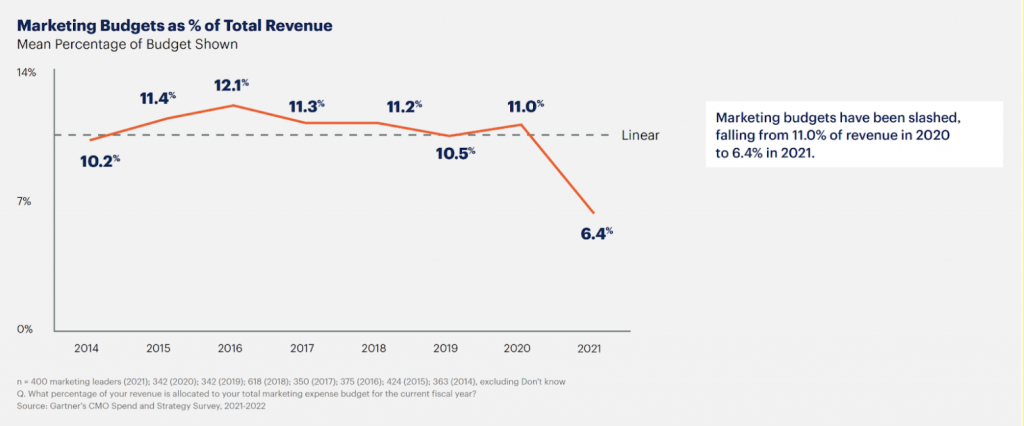 The annual CMO Spend Survey from Gartner is available and…well…it’s not pretty. Marketing budgets, as a proportion of company revenue, have fallen from 11% in 2020 to 6.4% in 2021, their lowest point in the history of this survey.
The annual CMO Spend Survey from Gartner is available and…well…it’s not pretty. Marketing budgets, as a proportion of company revenue, have fallen from 11% in 2020 to 6.4% in 2021, their lowest point in the history of this survey.
As well, pure-play digital channels account for 72.2% of the total marketing budget,
with CMOs indicating that they’re shifting offline budgets into digital spend and 29% of work that was previously carried out by external agencies has been moved to in-house teams during the last 12 months.
CMOs have focused in-house efforts on high-value, strategic capabilities such as brand strategy, innovation, and technology. The survey captures a snapshot of marketing’s
budget, spending, and strategic priorities. It finds CMOs at a difficult juncture — budgets and resources are constrained, but marketing needs to demonstrate how it can support the enterprise’s growth and transformation ambitions.
It’s kind of depressing news, but at the same time, there are tons of opportunities in here if you’re willing to look at it a bit differently.
I do find the survey data that marketing budgets are struggling to rebound fascinating.
We’ve never been busier nor with the exact, right clients for our agency. And, from what I hear, we’re not alone. Some of the Spin Sucks Community members who work at agencies have said the same.
Yet, the data doesn’t match these experiences, which makes me wonder if it just hasn’t hit yet and the sky will fall in 2022.
It does make sense that the majority of CMOs faced an in-year budget cut last year.
We certainly experienced that with our clients from March through June.
But it started to come back and then some in July and has been going full strength for more than a year now.
However, the survey shows CMOs anticipated a swift recovery and expected budgets to bounce back this year.
Marketing Budgets Haven’t Rebounded As Expected
More than half (56%) expected budget growth of more than 5% in 2021, but such a swift return to pre-pandemic funding levels proved elusive for many marketing organizations.
It’s also interesting to see that marketing budgets, as a percentage of total revenue, have always been between 10.2% and 12.1%, but fell to 6.4% this year.
That doesn’t bode well for forthcoming agency work.

The survey shows that these results reflect ongoing downward pressure on marketing spend induced by the pandemic, but also the variability and volatility associated with rapid digitization and enterprise resource allocation decisions.
In the first instance, several factors combined to ill effect on marketing budgets:
- Marketing budgets have always been the first of the enterprise budgets to be cut and the last to be restored.
- CFOs have become comfortable with the lower cost base that spending cuts in marketing, alongside savings on real estate and travel costs, have yielded.
- CMOs proved that they could do more with less, curbing spending on events, agencies, and ad budgets in the face of a crisis.
This year’s survey captures marketing budgets following a prolonged period of multiple, decremental budget cuts.
For many, there’s not been a single, joltingly precipitous drop in budget, but rather a steady erosion of marketing’s funds.
And so far, the enterprise has proved to be slow in replenishing marketing’s depleted coffers.
Cutting Marketing Budgets Means People Forget You’re There
One reason is that the effect of near-term marketing budget cuts on brand awareness and consideration are often not immediately appreciated, which should come as no surprise.
I’m willing to bet you’ve had an experience (or more than one) where you were asked to do more with less and did, but a year later, sales dropped significantly and no one knew why.
Oh, right! The organization stopped marketing so people forgot you were there.
According to a New Yorker story that ran during the Great Recession, Kellogg won in the eyes of consumers, while everyone else (including their competitors) failed. This is what they said:
In the late nineteen-twenties, two companies—Kellogg and Post—dominated the market for packaged cereal. It was still a relatively new market: ready-to-eat cereal had been around for decades, but Americans didn’t see it as a real alternative to oatmeal or cream of wheat until the twenties. So, when the Depression hit, no one knew what would happen to consumer demand. Post did the predictable thing: it reined in expenses and cut back on advertising. But Kellogg doubled its ad budget, moved aggressively into radio advertising, and heavily pushed its new cereal, Rice Krispies. (Snap, Crackle, and Pop first appeared in the thirties.) By 1933, even as the economy cratered, Kellogg’s profits had risen almost 30% and it had become what it remains today: the industry’s dominant player.
We need to demonstrate in our next budgeting cycle that the illusion of savings today presents a significant risk to tomorrow, as brands lose customer relevance, share of voice, and the ability to reach customers with targeted and timely messages.
CMOs Have Reprioritized Spending Commitments
Facing a reduction in resources, the survey shows that many have reprioritized the spending commitments across channels and programs.
Investments in pure-play digital channels, be they paid, earned, shared, or owned, account for 72.2% of the total marketing budget.

Looking at the budgets that have benefited from increased investment year-over-year, social marketing, SEO, and digital advertising topped the list of channel winners.
Offline advertising, mobile marketing, and events were the most likely to have faced budget cuts in the past year. But there also were some reallocations from those buckets to:
- Better meet the pace of change brought on advances in digital technology (47%)
- Improve brand awareness (40%)
- Gather data-driven insights from digital channels (39%)
According to the survey, this reflects the fact that customer journey disruptions brought about by the pandemic have prompted CMOs across industries to question long-held beliefs on the relative value of their channel investments.
Channels that have traditionally been seen as drivers of awareness are now vying for budget alongside those that have been considered as performance marketing channels, such as search and social advertising.
That shouldn’t really come as a big surprise.
For years now, executives have wanted us to prove that 100% of their budgets in marketing and communications have a return.
You Can’t Measure EVERYTHING
A couple of weeks ago, I talked you through how we discuss this with clients.
The gist of it is that, and you know this, you can’t correlate brand awareness and credibility directly to results.
Sure, you’re not going to have much success if no one knows who you are or what you do, but it’s not an apples-to-apples comparison like it is with search and social advertising.
It’s kind of a bummer brand awareness activities have to vie for the same budgets as the things that are more easily attributed to sales.
Alas.
All in all, the Gartner survey is pretty sad for our industry, but if the work that we—and my peers—are doing is any indication, it doesn’t reflect reality entirely.
When they release their next report, we’ll take a look and see what has changed.
If it’s still this depressing, I think we’ll all need to buckle down for a bumpy 2022.
But let’s cross that bridge if, and when, we need to.